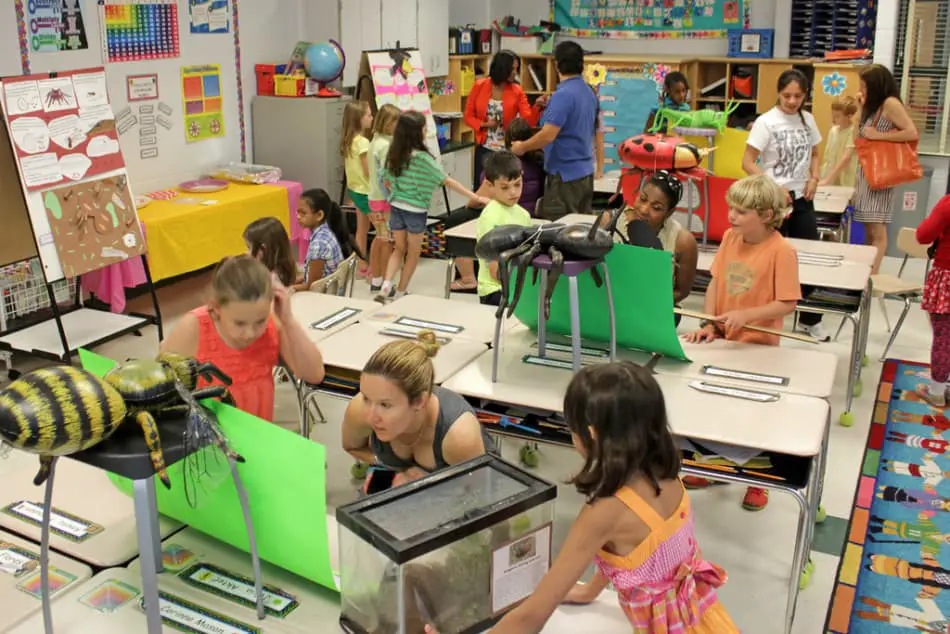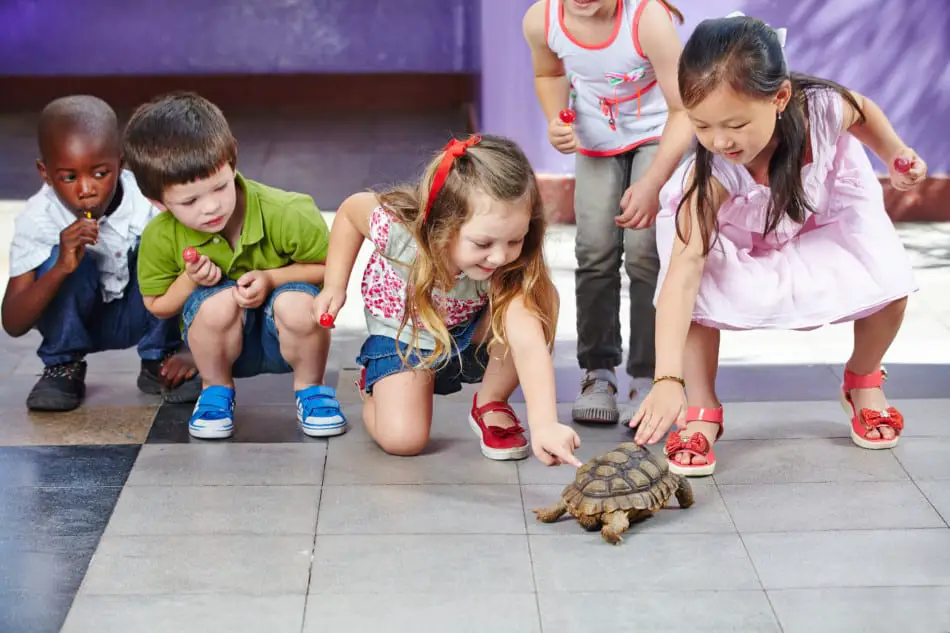A common debate is whether pets should be allowed in school. There are definite advocates for both sides. Some teachers say that pets teach responsibility. They also suggest that pets can help kids manage stress. While this may be true, the wellbeing of the pets concerned is not being taken into account. A classroom is a noisy, stressful place for a pet to be. This makes having pets in school potentially inhumane.
Should pets be allowed in school? There are compelling arguments for and against. The cons outweigh the pros, to put it simply. School pets can help students feel more relaxed and happy. But this is often at the cost to the pet. Poor conditions, stressful environment and poor handling of them make schools an unsuitable place for pets.

Table of Contents
Pros
Pets in school can help reduce stress
Pets are known to be excellent when it comes to therapy. Their happy natures tend to cheer and their affection reduces stress even on a purely hormonal level. Pets in school can be emotionally and mentally supportive.
Caring for and playing with school pets or visiting pets can be an effective positive diversion.
This begs the question, however; is lower stress for your child, but higher stress for your pet, a reasonable trade-off? There are surely less harmful ways to cope out there.
Pets can improve the attitude of students toward school
Kids love pets. Who doesn’t? Animals are sweet, selfless, sincere, and loyal. Having school pets can give kids something at school to look forward to. Kids enjoy grooming, playing with, and caring for pets.
They also like to simply observe. Many children would love to bring their cat or dog to school. Having a pet by their side can help students feel more at home.
Additionally, teachers can use pets in demonstrations, to keep students attentive. Posing math questions that involve a pet, for example.
All of this being said, while kids may like the company of their pet in school, the pet is not likely to feel the same. Once they begin to feel restless, overstimulated, bored, or hungry, they will probably be ready to go home.
Keeping them at school against their will is inhumane.
Pets in school can help teach students responsibility
Some teachers and parents claim that having pets in school can help teach students responsibility. This from taking turns in caring for the pets, presumably.
However, there is too much room for error. Pets are living creatures that feel emotions and pain. With all that is at stake, it is probably not worth the risk.
The same goes for dogs that visit… while the child may try, the dog will inevitably go without the proper rest, exercise, and attention.
Some feel that this is a fine trade-off and that pets should serve. Others find this inhumane.
A nice compromise is to have students practice responsibility with plants, instead. They are much simpler to care for, and will not suffer as much from neglect or improper care.
Students may water the plants, offer them plant food, trim off dead bits, add fresh soil, and more.
You can even go so far as to start a school garden. These provide the perfect environment for kids to learn responsible care.
Another fantastic idea is to take students to observe animals in their natural habitats. Plan a field trip to go bird-watching in the forest, catch frogs at a pond, or visit a local farm.
Cons
A school environment is unnatural for pets
First off, a school is nothing like a house. Arguably, pets deserve to spend the majority of their time in a secure and peaceful home.
Dogs nap a lot during the day. At school, dogs are kept awake by interaction and noise. The situation is even worse for mice, gerbils and other rodents.
These little guys are nocturnal. This means that they need plenty of sleep during the daytime. Night is when they are hungry, friendly, and active. In school, mice are disturbed by chatter, laughter, bright lights, and the school bell.
This creates an environment that is not only unnatural but honestly quite miserable.
Being kept in a cage all day is also unhealthy. Mice, gerbils, guinea pigs and the like are energetic little creatures. They need plenty of special time set aside, to play and explore.

School pets are neglected
One of the saddest things that pets at school experience is neglect. Despite the best intentions, children may not be the best caretakers. At some point, mistakes will almost certainly be made.
School pets are particularly neglected on weekends. With no one at school, they receive little stimulation. The environment is not monitored, either. Some very tragic situations occurred involving heat stroke or hypothermia, and the pets did not survive.
Pets are either left alone or sent with students for the holidays. There is no way to ascertain the hygiene of that environment or the quality of their care during this time.
Additionally, it can be difficult for folk to tell whether a pet is sick. This means that school pets are often slow to be treated properly. This leaves them in prolonged discomfort, and can even prove fatal.
A dog at school would not receive sufficient attention. At least, not without distracting students. Clearly, this would defeat the purpose. Dogs should be kept at home, where they can nap, eat, play, and be free.
School pets experience stress
Did you know that mice hate to be held? This is because they are prey animals. They experience a lot of fear about being snatched or grabbed. Unfortunately, students like to pick up and cuddle school pets.
To them, this is an important part of interaction.
Holding a mouse is alright at home, by the mouse’s owner, and in the right conditions. Otherwise, it is very scary for them and just plain cruel. Younger students may also cause school pets injury when they do not handle them with proper care.
The brightness and sounds in school not only keep pets awake but also cause them constant stress. Rodents and birds especially are easily surprised.
An accompanying dog may startle and bark at the sound of a bell.
When school pets are left alone for weekends or holidays, they become lonely or bored or suffer neglect. This causes them to feel depressed, restless and stressed as well.
Having pets at school is a health risk
When it comes to health, keeping pets at school and inviting pets to school is not wise. For one, many children have allergies and asthma. Certain animals and some types of bedding can make this worse.
Reptiles and amphibians even carry salmonella.
Rats, mice, guinea pigs and gerbils can also carry diseases that are transmittable. Unsurprisingly, the likelihood of illness and contagions is much higher with multiple pets and in a public place like a school.
Neglect can also be detrimental to the hygiene of school pets. When the bedding is not changed often enough, it will quickly turn filthy.
Hamsters in particular need sand baths to help keep themselves clean. Food can become soiled. In summation, pets deserve people that are always around, tidy, and attentive.

So, Should Pets Be Allowed In School?
No, pets should not be allowed in school. The cons outweigh the pros, to put it simply. School pets can help students feel more relaxed and happy.
Students are also said to learn responsibility from their care. Students claim that they can improve the overall atmosphere at school.
This is not without a cost, unfortunately. Very few pets would be content living in a school. Lizards, rodents, dogs, cats, and birds are all unsuitable.
No matter how nice the cage set up for the pets, a school environment will never be natural.
The bright lights necessary to see, and the noise inherent in public, are impossible to eliminate.
In school, pets are at risk of being frightened by sound and touch. They will experience overstimulation and then neglect, during school, and on weekends and holidays.
The resulting high levels of stress will lower their quality of life, and shorten their longevity. School pets may even become sick and get other pets and even students sick.
Luckily, there are some really lovely alternatives available. Invest in school plants instead of school pets.
These are more affordable, and much easier to care for. Neglect is unlikely to kill them or even harm them too badly. Compared to pets, plants experience very little distress or pain.
This makes plants an excellent alternative. Teachers can have their kids care for their own or class plants to learn to be more responsible.
Some schools even go the extra mile and implement an entire school garden.
Conclusion: Should Pets Be Allowed In School?
What does this mean? That there are many better, considerably more humane ways for students to learn responsibility, and to cope. People adore pets.
They are the best sort of creatures and very pleasant company. Keeping them in school may benefit kids, but it is detrimental to animals.
Rather than forcing this sort of life on them, keep your pet in a secure and peaceful home environment to express your respect and love. Instead, students can care for plants: a fun and reliable way to learn, risk-free.




